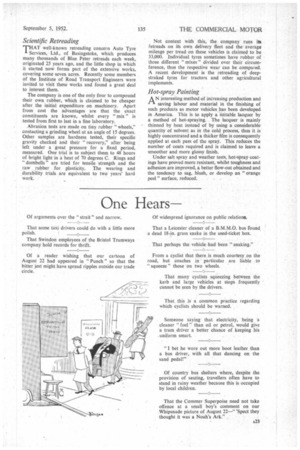Scientific Retreading
Page 25

If you've noticed an error in this article please click here to report it so we can fix it.
THAT well-known retreading concern Auto Tyre Services, Ltd., of Basingstoke, which produces many thousands of Blue Peter retreads each week, originated 25 years ago, and the little shop in which it started now forms part of the extensive works, covering some seven acres. Recently some members of the Institute of Road Transport Engineers were invited to visit these works and found a great deal to interest them.
The company is one of the only four to compound their own rubber, which is claimed to be cheaper after, the initial expenditure on machinery. Apart from cost the advantages are that the exact constituents are known, whilst every " mix " is tested from first to last in a fine laboratory.
Abrasion tests are made on tiny rubber "wheels," contacting a grinding wheel at an angle of 15 degrees. Other samples are hardness tested, their specific gravity checked and their "recovery," after being left under a great pressure for a fixed period, measured. One trial is to subject them to 48 hours of bright light in a heat of 70 degrees C. Rings and " dumbells " are tried for tensile strength and the raw rubber for plasticity. The wearing and durability trials are equivalent to two years' hard work. Not content with this, the company runs its fetreads on its own delivery fleet and the average mileage per tread on these vehicles is claimed to be 33,000. Individual tyres sometimes have rubber of three different " mixes " divided over their circumference, thus the respective wear can be compared. A recent development is the retreading of deepstraked tyres for tractors and other agricultural implements.
Hot-spray Painting
AN interesting method of inereasing production and saving labour and material in the finishing of such products as motor vehicles has been developed in America. This is to apply a suitable lacquer by a method of hot-spraying. The lacquer is mainly thinned by heat instead of by using a considerable quantity of solvent as in the cold process, thus it is highly concentrated and a thicker film is consequently applied at each pass of the spray. This reduces the number of coats required and is claimed to leave a smoother and more glossy finish.
Under salt spray and weather tests, hot-spray coatings have proved more resistant, whilst toughness and adhesion are improved, a better flow-out obtained and the tendency to sag, blush, or develop an "orange peel" surface, reduced.
















































































